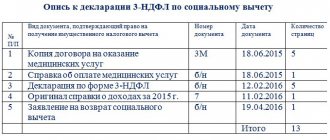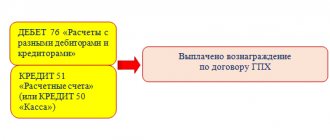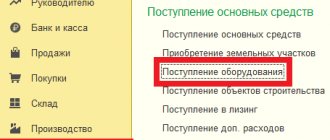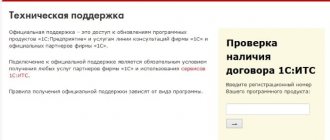Invoice updated: finding out the details
The absence of line 8 in the invoice can be attributed to errors that do not prevent the identification of the information listed above. Therefore, if the old invoice meets the requirements of paragraphs.
5 and 6 tbsp. 169 of the Tax Code of the Russian Federation, the tax authority does not have the right to refuse deductions on an invoice issued using an invalid form.
— Let’s assume that the buyer wants to play it safe and asks the seller to issue an invoice in the current form. Is the seller obligated to fulfill the buyer's request? And how exactly should the seller correct his mistake?
— If the buyer receives an invoice that is not in accordance with the established requirements, he has the right to contact his seller (supplier, contractor, performer, etc.) with a request to make appropriate corrections. And the seller must fulfill the buyer's request.
Changes in the purchase ledger and sales ledger since October
To do this, in the book settings, select “Generate additional sheets” and set the desired period.
The seller makes corrections to invoices by drawing up new copies of invoices.
Important changes have also been made to adjustment invoices. Previously, the law did not regulate the issue of whether the buyer was notified that an adjustment document was being drawn up. Now the book needs to reflect information about the document, which will confirm that the buyer was informed about the changes.
The purchase book should reflect the above changes in a similar way. 2 new columns were added to the sales book: “3a” – “Registration number of the customs declaration” and “3b” – “Product type code”. These changes will affect a few taxpayers: only those who either sell goods released for sale within the country, after passing the customs control procedure in the territory of the free customs zone of the special economic zone of the Kaliningrad region, or export goods to the countries of the EAEU.
What has changed in the purchase and sales books since October 1, 2021?
It is worth noting that the Ministry of Finance previously allowed the possibility of registering a primary business (letter dated November 19, 2015 No. 03-07-09/66869), but there was no official rule. In cases where an advance payment has been received, but an invoice has not been issued, information about the payment order must be entered into the register. In addition, it is permissible to indicate the details of the consolidated advance document received from the buyer.
New columns have been added to the updated form of the sales book: 3a “Registration number of the customs declaration” and 3b “Product type code”.
Column 3a needs to be filled in with data from the declaration; customs officers put the corresponding number in the first line of Column A of the main and additional sheets of the document.
We recommend reading: Procedure for transferring to shift work
How to fill out a purchase book when importing if there is no invoice
When filling out the purchase book, the cost of purchases in column 15 is taken from column 9 of the invoice (subparagraph “t”, paragraph 6 of Appendix 4 to Resolution No. 1137). If a company pays VAT at customs when importing goods, then it does not have an invoice. But you cannot leave column 15 empty - the information from it falls into line 170 of section 8 of the VAT return. If the company does not fill out the column, the deduction will not be reflected in the declaration.
The Ministry of Finance in letter No. 03-07-08/6235 explained that in column 15 you can write down the customs value of the goods, taking into account duties and VAT . This information must be taken from column 12 of the customs declaration.
The consignment value is usually expressed in foreign currency. The name and code of the currency must be filled in column 14 . This information can be taken from column 22 of the customs declaration. For example, euro, 978. But the amount of tax in column 16 should be written in rubles and kopecks (clause 8 of Appendix 4 to Resolution No. 1137).
Other information must be taken from the customs declaration.
Column 3 of the purchase book indicates the customs declaration number without a date. You can take it from column A of the main sheet of the declaration. Customs officers put this number in the first line of column A of the customs declaration, i.e. in the upper right corner of the document. It consists of three parts, separated by fractions. For example, 10902040/280116/0000244 (letter of the Federal Tax Service of Russia dated No. ED-4-15/1065).
In column 7 you should write down the date and number of the order to pay customs VAT. This data is recorded in column B “Counting details” of the goods declaration.
In column 9 - the name of the foreign supplier from column 2 “Sender/Exporter” of the customs declaration.
But column 10 of the purchase book with TIN and KPP empty. Here you only need to fill in Russian numbers (see below).
Registration number of the customs declaration
It has the following format (, approved.
The code in column 3b corresponds to the code of the type of goods imported from the EAEU states. If the company does not purchase such goods, this field is not required. The new provisions have changed the procedure for registering adjustment invoices, in particular, uniform adjustment documents.
By decision of the Customs Union Commission dated May 20, 2010 No. 257): XXXXXXXX/ XXXXXX/ XXXXXXX Element 1 Element 2 Element 3 Element 1 - code of the customs authority that registered the DT, in accordance with the classifiers of customs authorities used in the CU member states.
So, for example, the code of the Moscow customs is 10129000, and the Nakhodka customs code is 10714000. Element 2 is the registration date of the DT (day, month, last two digits of the year). Element 3 is the serial number of the DT, assigned according to the DT registration log by the customs authority that registered the DT. All elements of the registration number are indicated using the delimiter character “/” without spaces.
The above means that for the registration number of the customs declaration assigned by the Customs post of the Vostochny Seaport of Nakhodka customs, the sample may look like this: 10714040/140917/0090376 Until 10/01/2021 in addition to the registration
VAT amendments from October 1, 2021
Who fills it out?
N.Ch.: This column will be filled in only by residents of the SEZ in the Kaliningrad region when selling goods in respect of which they were exempt from paying “import” VAT upon completion of the customs procedure of the free customs zone or paid it in a special manner. It is for such cases that, starting with the declaration for the 1st quarter of 2021, a new line 035 has already appeared in Section 9 “Information from the sales book...”, which reflects the numbers of customs declarations. Now the indicators of the sales book and the declaration are brought into line.
Not to be confused with the information reflected in column 11 “Registration number of the customs declaration” of the invoice. When selling imported goods on the domestic market, the registration numbers of customs declarations from group 11 of the invoice in the sales book are not filled in. 2. From October 1, 2021, the provision that corrected invoices are registered in the purchase book as the right to tax deductions arises is excluded from the purchase book.
Import deduction
Firms usually pay value added tax to the budget at the end of the month or quarter in a total amount. However, there are exceptions to this situation. One of them is the tax paid at customs. Irina Pereletova, General Director of ZAO Consulting Group Zerkalo, will tell us how to take such amounts of VAT into account.
Svetlana BLINOVA GTD instead of an invoice
Importing companies pay VAT at customs when importing goods into Russia. The amount of tax you paid at customs can be deducted in your VAT return. As stated in paragraph 1 of Article 172 of the Tax Code, the basis for such a deduction will be documents that can confirm the fact that you actually paid the tax at customs. Such documents are a payment order (copy) for payment of VAT as part of customs payments and a cargo customs declaration (CCD).








